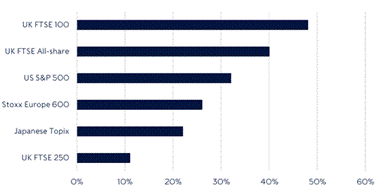If you had to name a market that’s highly concentrated, you would probably say the US. With the vast success of technology companies in the past few decades (and more recently of the Magnificent Seven stocks in the past year) just a handful of businesses now make up most of the S&P500 index. To be precise, the top-10 companies represent just over 30% of the whole index’ weighting.
But you needn’t look across the ocean to find an example of concentration. The domestic market is even more top-heavy, with the FTSE 100’s biggest companies almost reaching 50%, as the chart below shows.
Concentration in top-10 stocks
Source: FTSE, Bloomberg, S&P Dow Jones, Rathbones; data as of 29 February 2024
This means that investors who buy the index are directing half of their money towards 10 companies only – Shell, Astra Zeneca, HSBC, Unilever, BP, GSK, Relx, Diageo, Rio Tinto and Glencore.
Such concentration is a very poor deal for investors, said Leigh Himsworth, FE fundinfo Alpha Manager of the Fidelity UK Opportunities fund.
“The main reason for investing in a fund is to not have all your eggs in one basket and spread the risk, but one does not necessarily achieve this by investing largely in 10 stocks,” the manager said.
“A reliance on a small number of stocks to drive returns can introduce biases in portfolios and increase risk – problematic, if the stocks start to underperform as happened post the bursting on the TMT bubble back in early 2000.”
On top of that, only seven sectors are represented – older industries such as oil, banks, pharmaceuticals, mining, beverages and consumer goods, with little or no exposure to exciting new areas of growth, Himsworth continued.
“Being larger also tends to suggest lower rates of growth, a feature that many investing in the market are seeking, especially in an index fund, and even worse, an index-fund investor compounds their own problem, as the fund will continue to buy into this.”
David Smith, manager of the Henderson High Income Trust, agreed the issue is more relevant for passive investors, while active managers can make decisions to invest not just based on market capitalisation, but on companies’ valuations and the fundamental outlooks for their businesses.
“This means we can underweight or completely avoid large stocks that we think are expensive provided it is within the risk tolerances of the fund,” he said.
“The concentration of the UK market is well recognised by UK fund managers who are accustomed to dealing with some of the challenges it poses with regards to portfolio construction and ensuring sufficient diversification.”
While this might be true, even active managers are having a hard time staying away from benchmarks. BNY Mellon UK Income co-manager Tim Lucas admitted that “there is generally a risk that asset managers look to manage their portfolios too closely to their benchmarks and thus risk total returns to investors”.
“A key to circumvent this is to have a large number of shares to choose from when constructing a portfolio and to be willing to deviate from the benchmark,” he said.
But this is becoming more difficult to achieve in an industry that’s being pushed into owning the same assets – not least for the career risk that derives from going against the grain, as IBOSS’ Metcalfe recently told Trustnet.
One option is for fund managers to put a proportion of the fund into off-benchmark holdings, such as overseas investments – which they are allowed to do. However, this comes with its own pros and cons.
Another issue is that fund managers must take enormous bets on some of the UK’s largest companies that they are in favour of, a problem highlighted by Alexandra Jackson, manager of the Rathbone UK Opportunities Fund. She said it can be hard for active managers to even be at an equal weighting to the index.
“Doing so would mean jettisoning reasonable diversification and taking on huge risks that wouldn’t benefit investors. In some cases, it would nudge close to, or even exceed, regulatory limits on position sizes,” she said.
To mitigate these risks, Jackson is looking at the FTSE 250, where the 10 largest businesses account for just 11% of the UK mid-cap equity index so it’s well-diversified.
“I believe this makes it easier to spot quality companies flying under the radar. Many of these businesses are little known, with strong opportunities for growth both at home and abroad,” she said.
“And they seem cheap relative to their counterparts in other markets and when compared with the past, with sausage-maker Cranswick and fund administrator JTC being two examples”.
Lucas agreed, noting that he is seeing “a large number of choices all way through the FTSE 350”. “The limit in being able to invest in these shares is liquidity, meaning that investors should pay attention to make sure that the fund size is not too large. Very large funds are not easily able to invest in smaller companies without taking on more liquidity risk, if they invest exclusively in the UK,” he said.





